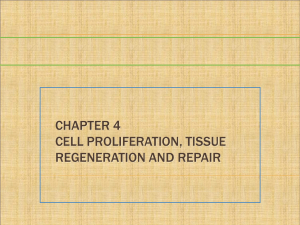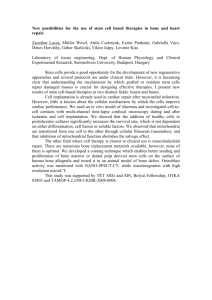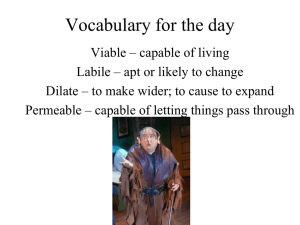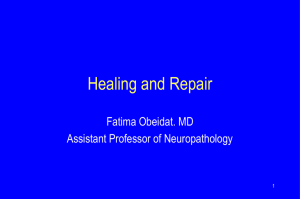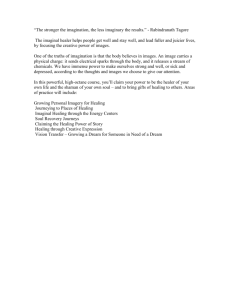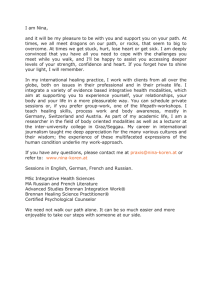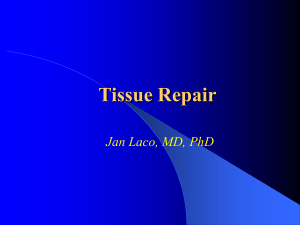HEALING &TISSUE REPAIR REGENERATION & HEALING BY
advertisement
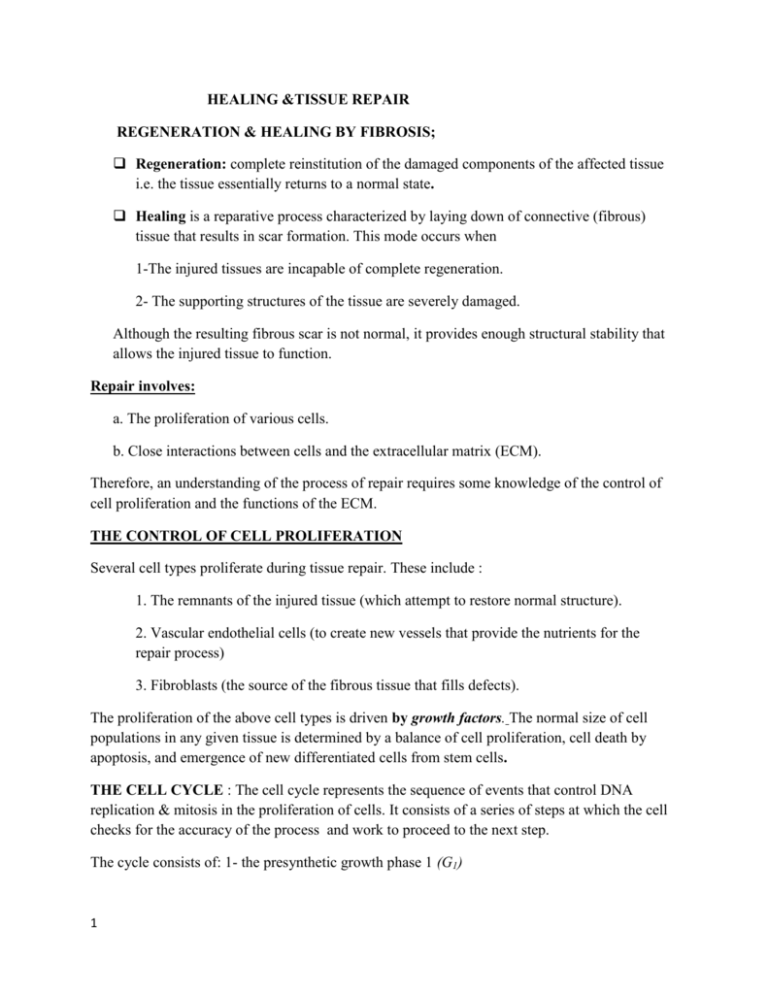
HEALING &TISSUE REPAIR REGENERATION & HEALING BY FIBROSIS; Regeneration: complete reinstitution of the damaged components of the affected tissue i.e. the tissue essentially returns to a normal state. Healing is a reparative process characterized by laying down of connective (fibrous) tissue that results in scar formation. This mode occurs when 1-The injured tissues are incapable of complete regeneration. 2- The supporting structures of the tissue are severely damaged. Although the resulting fibrous scar is not normal, it provides enough structural stability that allows the injured tissue to function. Repair involves: a. The proliferation of various cells. b. Close interactions between cells and the extracellular matrix (ECM). Therefore, an understanding of the process of repair requires some knowledge of the control of cell proliferation and the functions of the ECM. THE CONTROL OF CELL PROLIFERATION Several cell types proliferate during tissue repair. These include : 1. The remnants of the injured tissue (which attempt to restore normal structure). 2. Vascular endothelial cells (to create new vessels that provide the nutrients for the repair process) 3. Fibroblasts (the source of the fibrous tissue that fills defects). The proliferation of the above cell types is driven by growth factors. The normal size of cell populations in any given tissue is determined by a balance of cell proliferation, cell death by apoptosis, and emergence of new differentiated cells from stem cells. THE CELL CYCLE : The cell cycle represents the sequence of events that control DNA replication & mitosis in the proliferation of cells. It consists of a series of steps at which the cell checks for the accuracy of the process and work to proceed to the next step. The cycle consists of: 1- the presynthetic growth phase 1 (G1) 1 2-the DNA synthesis phase(S) 3-the premitotic growth phase2(G2) 4-and the mitotic phase (M). Non-dividing cells are either in cell cycle arrest in G1 or they exit the cycle to enter a phase called G0. Any stimulus that initiates cell proliferation, such as exposure to growth factors, needs to promote the G0/G1 transition and the entry of cells into the G1. Further progression is determined by the ability of the cell to pass through an intrinsic quality control mechanism for cell integrity, known as checkpoint control. Checkpoint controls prevent DNA replication or mitosis of damaged cells and either transiently stop the cell cycle to allow for DNA repair or eliminate irreversibly damaged cells by apoptosis. Progression through the cell cycle from G1 is regulated by proteins called cyclins, which form complexes with enzymes called cyclin-dependent kinases (CDKs). These complexes regulate the phosphorylation of proteins involved in cell cycle progression leading to DNA replication and mitosis, and thus are required for cell cycle progression. A major action of growth factors is to overcome the checkpoint controls by liberating the suppression of CDK activity. Once cells enter the S phase, the DNA is replicated and the cell progresses through G2 and mitosis. Proliferative Capacities of Tissues: The tissues of the body are divided into three groups: 1-Continuously Dividing Tissues (labile tissues): cells of these tissues are continuously being lost and replaced by maturation from stem cells and by proliferation of mature cells. Labile cells include: hematopoietic cells in the bone marrow and the majority of surface epithelia. These tissues can readily regenerate after injury provided the pool of stem cells is preserved. 2. Stable Tissues: Cells of these tissues are quiescent (in the G0 stage of the cell cycle) and have only minimal replicative activity in their normal state. These cells are capable of proliferating in response to injury or loss of tissue mass. Stable cells constitute the parenchyma of most solid tissues, such as liver cells They also include endothelial cells, fibroblasts, and smooth muscle cells; the proliferation of these cells is particularly important in wound healing. With the exception of liver, stable tissues have a limited capacity to regenerate after injury. 2 3-Permanent Tissues: Cells of these tissues are terminally differentiated and nonproliferative in postnatal life. The majority of neurons and cardiac muscle cells belong to this category. Accordingly, injury to brain or heart is irreversible and results in a scar. Skeletal muscle is usually classified as a permanent tissue. Stem Cells: In most continuously dividing tissues the mature cells are terminally differentiated and shortlived. As mature cells die they are compensated for by identical differentiated cells generated from stem cells. Thus, in these tissues there is a homeostatic equilibrium between the replication and differentiation of stem cells and the death of the mature, fully differentiated cells. Such relationships are particularly evident in the multilayered epithelium of the skin and the gastrointestinal tract, in which stem cell positions have been identified near the basal layer of the epithelium. Cells differentiate progressively as they migrate to the upper layers of the epithelium; they ultimately die and are shed from the surface of the tissue. Stem cells are characterized by two important properties: 1. Self-renewal capacity 2. Asymmetric replication which means that after each cell division, some progeny enter a differentiation pathway, while others remain undifferentiated, retaining their self-renewal capacity. Stem cells with the capacity to generate multiple cell lineages (pluripotent stem cells) can be isolated from embryos and are called embryonic stem (ES) cells. Stem cells are normally present in proliferative tissues and generate cell lineages specific for the tissue. It is now recognized that stem cells with the capacity to generate multiple lineages are present in the bone marrow and several other tissues of adult individuals. These cells are called tissue stem cells or adult stem cells. Bone marrow stem cells have the ability to generate fat, cartilage, bone, endothelium, and muscle. Regenerative medicine has a main objective of regeneration and repopulation of damaged organs using ES or adult stem cells. One of the most exciting prospects in this field is the type of stem cell therapy known as therapeutic cloning. GROWTH FACTORS; Cell proliferation can be triggered by : 1. Growth factors 2. Hormones 3. Cytokines 4. Signals from the ECM 3 The polypeptide growth factors have a major role of promoting cell survival and proliferation, which are important in regeneration and healing. These proteins expand cell populations by stimulating cell division as well as by promoting cell survival through protection from apoptotic death. Most growth factors also stimulate migration, differentiation, & the synthesis of specialized proteins (such as collagen in fibroblasts). They induce cell proliferation by binding to specific receptors and by doing so affect the expression of genes through : 1. Relieving blocks on cell cycle progression (thus promoting replication), 2. Preventing apoptosis 3. Enhancing the synthesis of cellular proteins in preparation for mitosis EXTRACELLULAR MATRIX (ECM) AND CELL-MATRIX INTERACTIONS Tissue repair depends not only on growth factor activity but also on interactions between cells and ECM components. The ECM is a dynamic, constantly remodeling macromolecular complex synthesized locally, which assembles into a network that surrounds cells. It constitutes a significant proportion of any tissue. By supplying a substrate for cell adhesion and serving as a reservoir for growth factors.ECM regulates the proliferation, movement, and differentiation of the cells living within it. Synthesis and degradation of ECM accompanies wound healing & chronic fibrotic processes. ECM found in two basic forms: 1-Interstitial matrix:It presents in the spaces between mesenchymal (connective tissue) cells, and between epithelium and supportive vascular and smooth muscle structures. It is synthesized by the mesenchymal cells (e.g., fibroblasts). Its major constituents are: 1-Fibrillar and nonfibrillar collagens, 2-Fibronectin, 3-Elastin, 4-Proteoglycans, and 5-Hyaluronate, 2. Basement membrane: Which lies beneath the epithelium and is synthesized by overlying epithelium and underlying mesenchymal cells. Its major constituents are amorphous nonfibrillar type IV collagen and laminin. Adhesive Glycoproteins and Adhesion Receptors Adhesive glycoproteins and adhesion receptors are structurally diverse molecules involved in: 1-cell-to-cell adhesion 2-the linkage between cells and ECM. 3- binding between ECM components. 4 The adhesive glycoproteins include: fibronectin (major component of the interstitial ECM) and laminin (major constituent of basement membrane). The adhesion receptors, also known as cell adhesion molecules (CAMs), are grouped into four families: 1. Immunoglobulins , 2. Selectins , 3. Cadherins and 4. Integrins CELL AND TISSUE REGENERATION Cell renewal occurs continuously in labile tissues, such as the bone marrow, gut epithelium, and the skin. Damage to epithelia or an increased loss of blood cells can be corrected by the proliferation and differentiation of stem cells and, in the bone marrow, by proliferation of more differentiated progenitors. The renewal of hematopoietic cells is driven by growth factors called colony-stimulative factors (CSFs), which are produced in response to increased consumption or loss of blood cells. The regenerative response of the liver that occurs after surgical removal of hepatic tissue is striking. Up to 60% of the liver may be removed in a procedure called living-donor transplantation, in which a portion of the liver is resected from a normal individual and is transplanted into a recipient with end-stage liver disease , or after partial hepatectomies performed for tumor removal. In such cases, the tissue resection triggers proliferation of the remaining hepatocytes (normally quiescent). Experimentally, hepatocyte replication after partial hepatectomy is initiated by cytokines (e.g., tumor necrosis factor [TNF] and interleukin 6 [IL-6). It should be emphasized that extensive regeneration or compensatory hyperplasia can occur only if the residual tissue is structurally and functionally intact, as after partial surgical resection. By contrast, if the tissue is damaged by infection or inflammation, regeneration is incomplete and is accompanied by scarring. REPAIR BY CONNECTIVE TISSUE Healing or repair by connective tissue is encountered if 1. A severe or persistent (chronic) tissue injury that result in damage to parenchymal cells . 2. Injury affects nondividing cells. Under these conditions, repair occurs by replacement of the nonregenerated cells with connective tissue, or by a combination of regeneration of some cells and scar formation. Repair begins within 24 hours of injury by the emigration of fibroblasts and the induction of fibroblast and endothelial cell proliferation. By 3 to 5 days, a specialized type of tissue that is characteristic of healing, called granulation tissue is apparent. 5 The term granulation tissue derives from the pink, soft, granular gross appearance, such as that seen beneath the scab of a skin wound.Its microscopic appearance is characterized by proliferation of fibroblasts and new thin-walled, delicate capillaries (angiogenesis), in a loose ECM. Granulation tissue then progressively accumulates connective tissue matrix, eventually resulting in the formation of a scar which may remodel over time. Repair by connective tissue deposition consists of four sequential processes: 1-Formation of new blood vessels (angiogenesis) 2-Migration and proliferation of fibroblasts 3-Deposition of ECM (scar formation) 4-Maturation and reorganization of the fibrous tissue (remodeling) Angiogenesis (neovascularization) : The preexisting vessels send out capillary sprouts to produce new vessels. Angiogenesis is a critical process: 1-in healing at sites of injury 2-in the development of collateral circulations at sites of ischemia 3-and in allowing tumors to increase in size beyond the limits of their original blood supply. New vessels formed during angiogenesis are leaky. This leakiness explains why granulation tissue is often edematous, and accounts in part for the edema that may persist in healing wounds long after the acute inflammatory response has resolved. Migration of Fibroblasts and ECM Deposition (Scar Formation) Scar formation builds on the granulation tissue framework of new vessels and loose ECM that develop early at the repair site. It occurs in two steps: 1. Migration and proliferation of fibroblasts into the site of injury and 2. Deposition of ECM by these cells. Macrophages, in particular, are important cellular constituents of granulation tissue, and besides clearing extracellular debris and fibrin at the site of injury. Healing by First Intention One of the simplest examples of wound repair is the healing of a clean, uninfected surgical incision approximated by surgical sutures. This is referred to as primary union or healing by first intention. The incision causes only focal disruption of epithelial basement membrane continuity and death of a relatively few epithelial and connective tissue cells. As a result, epithelial regeneration predominates over fibrosis. A small scar is formed, but there is minimal wound contraction. The narrow incisional space first fills with fibrin-clotted blood. Those events following these steps; 6 1-Within 24 hours, neutrophils are seen at the incision margin, migrating toward the fibrin clot. 2-Within 24 to 48 hours, epithelial cells from both edges have begun to migrate and proliferate along the dermis. The cells meet in the midline beneath the surface scab, yielding a thin but continuous epithelial layer. 3-By day 3, neutrophils have been largely replaced by macrophages, and granulation tissue progressively invades the incision space. Epithelial cell proliferation continues, yielding a thickened epidermal covering layer. 4-By day 5, neovascularization reaches its peak as granulation tissue fills the incisional space. The epidermis recovers its normal thickness as differentiation of surface cells yields a mature epidermal architecture with surface keratinization. 5-During the second week, there is continued collagen accumulation and fibroblast proliferation that bridge the incision. The leukocyte infiltrate, edema, and increased vascularity are diminished 6-By the end of the first month, the scar comprises a cellular connective tissue largely devoid of inflammatory cells and covered by an essentially normal epidermis. The tensile strength of the wound increases with time. However, the dermal appendages destroyed in the line of the incision are permanently lost. Healing by Second Intention (healing by secondary union) When cell or tissue loss is more extensive, the repair process is more complex, the inflammatory reaction is more intense, there is abundant development of granulation tissue, and the wound contracts by the action of myofibroblasts. This is followed by accumulation of ECM and formation of a large scar. This mode of healing occurs in 1-Large wounds 2-Abscesses 3-Ulcerations Secondary healing differs from primary healing in several respects: 1-A larger clot or scab rich in fibrin and fibronectin forms at the surface of the wound. 2-Inflammation is more intense because large tissue defects have a greater volume of necrotic debris, exudate, and fibrin that must be removed. 3-Much larger amounts of granulation tissue are formed. A greater volume of granulation tissue generally results in a greater mass of scar tissue. 4-Secondary healing involves wound contraction. Within 6 weeks, for example, large skin defects may be reduced to 5% to 10% of their original size, largely by contraction. This process has been ascribed to the presence of myofibroblasts, which are modified fibroblasts exhibiting many of the ultrastructural and functional features of contractile smooth muscle cells. 7 5-Wound strength reaches approximately 70% to 80% of normal by 3 months but usually does not substantially improve beyond that point. PATHOLOGIC ASPECTS OF REPAIR Wound healing may be affected by several external or internal influences that reduce the quality or adequacy of the reparative process. Particularly important are infections and diabetes. 1. Infection is the single most important cause of delay in healing; it prolongs the inflammation phase of the process and potentially increases the local tissue injury. 2. Nutrition has profound effects on wound healing; protein deficiency & vitamin C deficiency, inhibits collagen synthesis and retards healing. 3. Glucocorticoids (steroids) have anti-inflammatory effects, and their administration may result in poor wound strength due to diminished fibrosis. 4. Mechanical variables such as increased local pressure or torsion may cause wounds to pull apart, or dehisce i.e. open out or gape. 5. Poor perfusion, due either to arteriosclerosis and diabetes or to obstructed venous drainage (e.g. in varicose veins), also impairs healing 6. Foreign bodies such as fragments of steel, glass, or even bone impede healing. 7. The type (and volume) of tissue injured is critical. Complete restoration can occur only in tissues composed of stable and labile cells; 8. The location of the injury and the character of the tissue in which the injury occurs are also important. For example, inflammation arising in tissue spaces (e.g., pleural, peritoneal, synovial cavities) develops extensive exudates Aberrations of cell growth and ECM production This may occur even in what begins as normal wound healing. 1. Keloid refers to the accumulation of exuberant amounts of collagen that give rise to prominent, raised scars. 2. Disabling fibrosis associated with chronic inflammatory diseases such as rheumatoid arthritis, pulmonary fibrosis 3. Exuberant granulation: healing wounds may also generate excessive granulation tissue that protrudes above the level of the surrounding skin and hinders re-epithelialization. 8 Healing of fractures Fractures rank among the most common bone pathologies. They are classified as: complete or incomplete closed when the overlying tissue is intact, or compound when the fracture extends into the overlying skin comminuted when the bone is splintered displaced , when the fractured bone is not aligned In all cases, the repair of a fracture is a highly regulated process that involves overlapping stages: The trauma of the bone fracture ruptures associated blood vessels; the resulting blood coagulum creates a fibrin mesh scaffold to recruit inflammatory cells, fibroblasts, and endothelium. platelets and inflammatory cells subsequently release a host of cytokines (e.g., platelet-derived growth factor and FGF) that activate bone progenitor cells, and within a week, the involved tissue is primed for new matrix synthesis. This soft tissue callus is able to hold the ends of the fractured bone in apposition, but it is non-calcified and cannot support weight bearing. Bone progenitors in the medullary cavity deposit new foci of woven bone, and activated mesenchymal cells at the fracture site differentiate into cartilage-synthesizing chondroblasts. In uncomplicated fractures, this early repair process peaks within 2-3 weeks. The newly formed cartilage acts as a nidus for endochondral ossification, recapitulating the process of bone formation in epiphyseal growth plates. This connects the trabeculae in adjacent bone. With ossification, the fractured ends are bridged by a bony callus.Although excess fibrous tissue, cartilage, and bone are produced in the early callus, subsequent weight-bearing leads to resorption of the callus from non-stressed sites; at the same time there is fortification of regions that support greater loads. This callus remodeling restores the original size and shape of the bone, including the spongy cancellous architecture of the medullary cavity. 9
